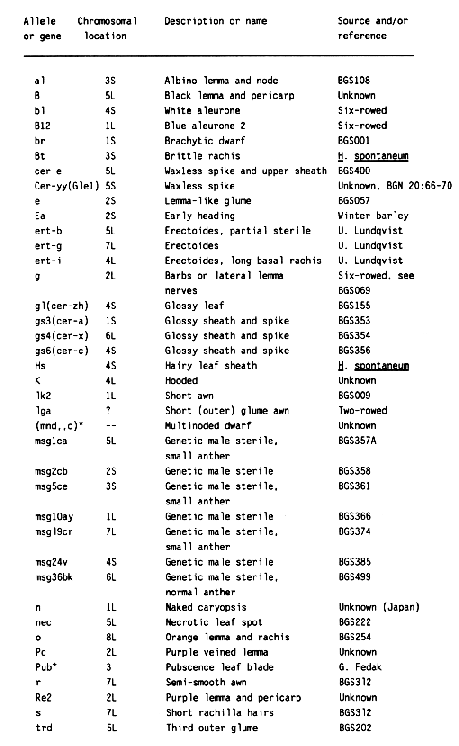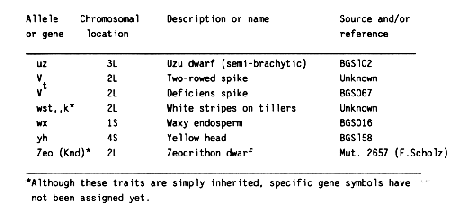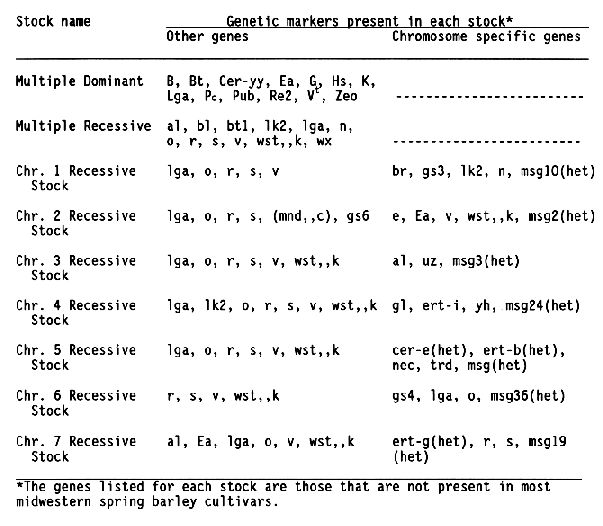

The morphological markers of barley, Hordeum vulgare L., are an important genetic resource that can be used to map desirable genes, examine biochemical pathways, and transfer genes to improved cultivars. To facilitate utilization of this tool, selected dominant and recessive markers have been placed in early maturing, spring growth habit lines. The nine multiple markers lines (stocks) described in this paper contain over 40 simply inherited, morphological characteristics (Hockett and Nilan, 1985; Nilan, 1964; Smith, 1951). Preliminary information on these stocks was reported by Franckowiak (1986) and Wolfe (1972, 1984).
Two multiple marker stocks, one for dominant traits and one for recessive traits, were generated for initial mapping of new genes. In addition, one multiple recessive marker stock was developed for each of the seven barley chromosomes. The seven chromosome specific recessive marker stocks were developed to aid in localization of specific genes. Each of the seven chromosome specific marker stocks contain some of the traits found in the primary recessive marker stock plus genetic male sterility, plant height, and surface wax mutants. These traits are excluded from the primary recessive marker stock. The marker stocks have an advantage over the original mutant stocks because they are more uniform in maturity and growth habit and are easy to use as female parents in crosses. Also the number of crosses that need to be examined in mapping studies is reduced.
The original mutant stocks were collected in the 1960's and maintained at Brandon, Manitoba until crossed to locally adapted cultivars. Markers that were expressed as monogenic traits in field nurseries of Brandon were selected for incorporation into multiple marker stocks if seedlings expressing the morphological markers had good vigor. During multiple marker stock development, selection for earliness, seedling vigor, and tolerance to local diseases and environment constraints was practiced. Some decisions to incorporate specific genes into a given multiple marker stock were based on incomplete linkage or gene interaction information. Therefore, certain gene combinations produced very weak plants, some genes were placed into the wrong stock, and recombinants between some closely linked markers were not obtained. The effects of these problems are reflected in part in the markers retained in the individual chromosome stocks.
Since the genetic male steriles, surface wax mutants, and semidwarfs are morphological traits that have similar effects, only one in each class was chosen to develop the stock for each chromosome. As many recessive genes as possible were retained from the primary multiple recessive stock. Combining a genetic male sterile with a semidwarf gene was successful for five of the seven chromosomes and a surface wax mutant was placed into four of the seven individual chromosome stocks. Shrunken endosperm and chlorophyll mutants could not be included in the marker stocks while maintaining seed set and seedlinq vigor.
The simply inherited, genetic markers present in the multiple marker stocks are listed in Table 1. The dominant or recessive allele listed generally is the one that is least common in spring, six-rowed barleys of Manchurian origin. Because some markers were not identified until after the marker stocks were developed, only the presumptive origin of these genes could be listed in Table 1. Also, part of the original correspondence regarding the origin of certain genes was lost and the specific origin listed in Table 1 may be only a guess. The genetic markers present in each multiple marker stock are tabulated in Table 2.
The primary dominant and recessive genetic marker stocks will be maintained as homozygous lines. However, the seven chromosome specific marker stocks need to be maintained as heterozygotes because they each carry a male sterility gene. For seed distribution, small seed lots harvested from F1 or fertile F2 plants will be made available.
References:
Franckowiak, J. D. 1986. Multiple marker stocks from Beaverlodge, Canada. BGN 16:125-126.
Hockett, E. A., and R. A. Nilan. 1985. Genetics. p. 187-230. In D. C. Rasmusson (ed.) Barley Monograph No. 26. Am. Soc. Agron., Madison, WI.
Nilan, R. A. 1964. The cytology and genetics of barley 1951-1962. Monographic Supplement No. 3. Research Studies 32, No. 1. p. 93-176, Washington State Press, Pullman.
Smith, L. 1951. Cytology and genetics of barley. Bot. Rev. 1:1-51; 133-202; 285-355.
Wolfe, R. I. 1972. A multiple stock in Brandon, Canada. BGN 2:170.
Wolfe, R. I. 1984. Multiple dominant and recessive genetic marker stock development. Barley Newsl. 27:41.


